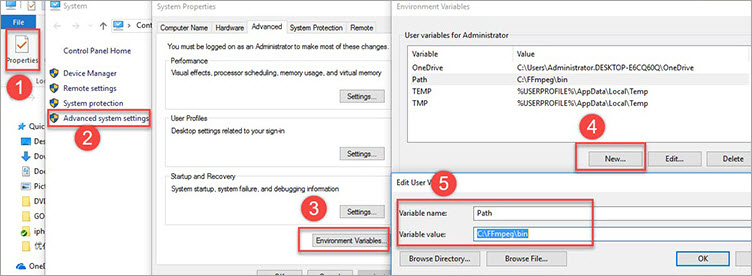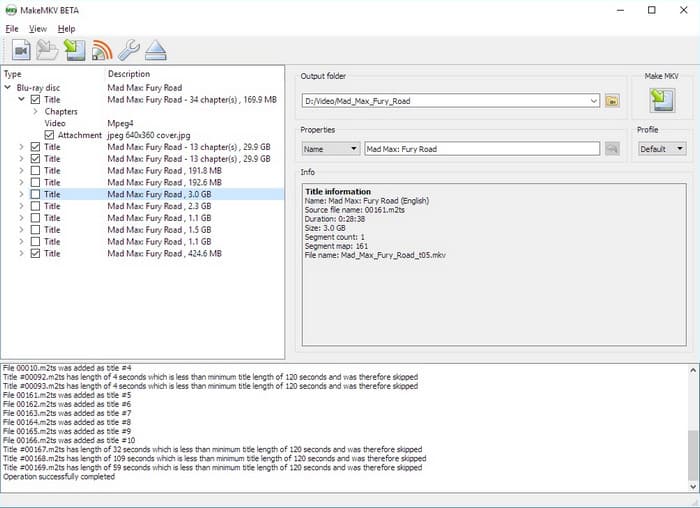

mkv, etc), you can choose the appropriate audio track that you want to export. ffmpeg -i Bbear.mkv -c:v mpeg4 -c:a libvorbis BbearENCODEvid-aud.mp4 Note : In case you are converting to mp4, these are some of the favorites codecs that you can use ( mpeg4, libx264, libvpx-vp9 and libxvid ) on the other hand, you can choose from the following audio codecs ( libfaac, libfdkaac, libvorbis, libmp3lame, and acc ). Check out using:commandlineusage Avidemux Note: If there are multiple audio tracks (e.g., one audio stream for each language in a movie file) in one media container (.mp4. to see diagnostic information about FFmpeg detection. Avidemux does support command-line/batch operations using avidemux.exe or avidemuxcli.exe. You can also choose Help > Diagnostics > Show Log. I tried this command first which is supposed to be the fastest way to convert mkv to mp4. button to obtain the correct library for your operating system. So I am trying to convert a really long video from MKV to MP4.

If you still see "not found", you may have installed the wrong libraries.
Click Open then OK and OK again to close Preferences.įFmpeg Library Version should now show a set of three version numbers for the sub-libraries of FFmpeg ("F" for libavformat version, "C" for libavcodec version and "U" for libavutil version).  Navigate to the folder that contains FFmpeg, and select the file avformat-55.dll. If the " Locate FFmpeg" dialog appears, click Browse. If a " Success" message indicates Audacity has now automatically detected valid FFmpeg libraries and asks if you want to detect them manually, click No, then OK to close Preferences. (example of 9 videos concatenated together with unique transitions) (note. To do this, access Preferences then the "Libraries" tab on the left:Īs seen in the image above, the "FFmpeg Library Version" will say "not found". Compatible with Windows, Mac, and Linux, FFmpeg uses a line command to get the task done gif -i audio There are several options available to you when exporting an animated gif exe is located, or place the ffmpeg ffmpeg profile, But to tackle HEVC/H ffmpeg profile, But to tackle HEVC/H. It is pertinent to note that you only have to add. FFmpeg -i inputfile.mp4 -acodec copy -vcodec copy -f mov outputfile. If you installed FFmpeg while Audacity was running, or if you installed FFmpeg to a non-default location, Audacity will ask you to configure Preferences to locate the FFmpeg library. Following is a command which enables FFmpeg to convert MP4 to MOV format.
Navigate to the folder that contains FFmpeg, and select the file avformat-55.dll. If the " Locate FFmpeg" dialog appears, click Browse. If a " Success" message indicates Audacity has now automatically detected valid FFmpeg libraries and asks if you want to detect them manually, click No, then OK to close Preferences. (example of 9 videos concatenated together with unique transitions) (note. To do this, access Preferences then the "Libraries" tab on the left:Īs seen in the image above, the "FFmpeg Library Version" will say "not found". Compatible with Windows, Mac, and Linux, FFmpeg uses a line command to get the task done gif -i audio There are several options available to you when exporting an animated gif exe is located, or place the ffmpeg ffmpeg profile, But to tackle HEVC/H ffmpeg profile, But to tackle HEVC/H. It is pertinent to note that you only have to add. FFmpeg -i inputfile.mp4 -acodec copy -vcodec copy -f mov outputfile. If you installed FFmpeg while Audacity was running, or if you installed FFmpeg to a non-default location, Audacity will ask you to configure Preferences to locate the FFmpeg library. Following is a command which enables FFmpeg to convert MP4 to MOV format.







 0 kommentar(er)
0 kommentar(er)
